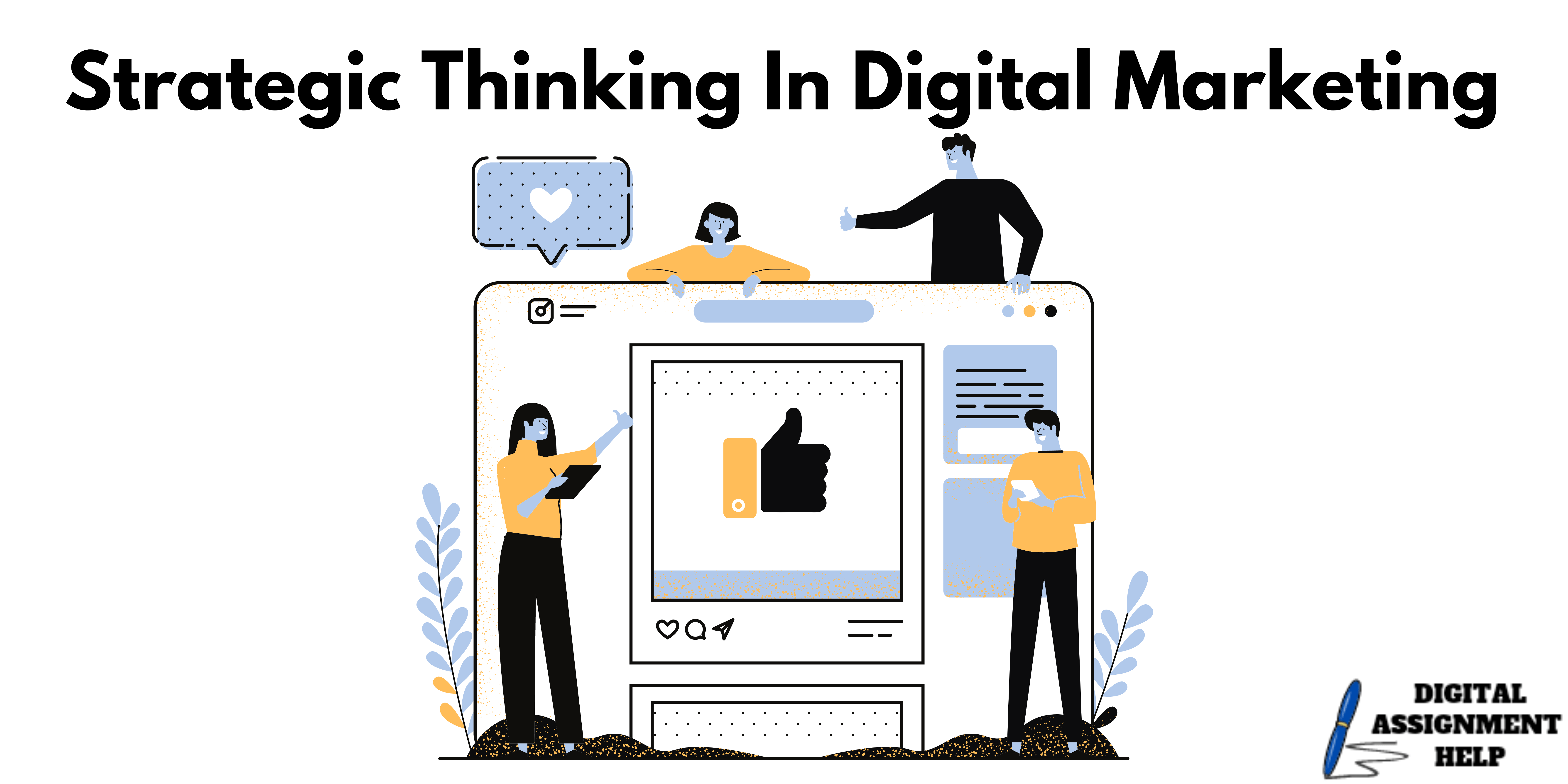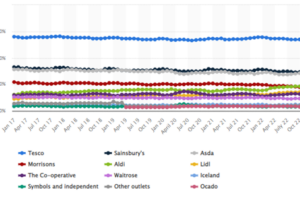
Strategic Thinking in Digital Marketing
- Posted by digital assignment
- Categories Management
- Date 24/04/2022
Strategic thinking entails long-term planning. This entails devising techniques and conjuring concepts that can adapt to changing circumstances.
PHASE 3 – Strategy Formulation
- ASSUMPTIONS
Strategic assumptions form “an identical, underlying foundation for the strategic plan.
They underpin everything contained therein – and hence reflect the vision, strategic map,
Performance targets and project portfolio which subsequently follow” (Hollingworth, 2008).
It is assumed that:
- Uncertainty around restrictions on retail will continue throughout 2021, further driving the growth of shopping for the home online.
- D&R have 10,000 one-time buyers and 7,000 of these are opted in for email marketing.
- D&Rs average order value is £125.
6. Marketing Strategies and Objectives
6.1 Strategic Decision Making
Strategic marketing decisions can be viewed as the marketing decisions an organization
makes that are of consequence to its long-term performance (Varadarajan, 2010).
Marketing decisions specify the marketing actions, activities or behaviors to engage
with in the marketplace and are related to building competitive advantage (Varadarajan, 2010).
To decide on strategic direction, the Ansoff Matrix is a planning technique used by marketers
to provide judgment about business growth through product and market extension networks (Hussain et al, 2013).
It is a 2×2 grid that considers 4 main growth strategies: market penetration, market development, product development and diversification.
For D&Rs business growth the market penetration strategy will be adopted.
This is a low-risk strategy that is based on selling more of existing products to existing markets (Wilson & Hines, 2009).
The earlier segmentation section, and figure 13, identifies a high search interest for lighting products in London,
as well as being a key traffic driver to the site.
Therefore, a market penetration strategy for D&R is to increase sales of lighting products amongst consumers living in London.
6.2 Targeting & Objective Setting
Concentrated target marketing is “when an organisation directs its marketing efforts towards
a single market segment by creating and maintaining one marketing mix” (Dibb 2012, p.240).
It allows organisations to specialise in the characteristics of a consumer group and focus efforts on satisfying those needs (Dibb, 2012).
Clifford & Cavanagh (1985) identified successful business growth is achieved through meeting the needs of certain customers,
with certain products. Not all customers with all products.
The Pareto effect recognises that 80% of profits come from 20% of customers (Chaffey, 2020)
and repeat customers generate revenue 16x more efficiently than one-time customers (Palnitkar, 2018).
If a company converts 10% of one-time customers into repeat purchasers,
revenue significantly increases by 37.5% (Palnitkar, 2018). This identifies customer retention as critical to business growth.
D&R will develop a concentrated targeted approach that focuses on the sale
of lighting products to consumers in London and increasing customer retention.
To achieve this, objectives must be set.
Objectives translate the marketing strategy into actions, “an objective is what you want to achieve.
A strategy is how you plan to achieve your objective” (McDonald & Wilson, 2016, p.62).
All objectives should be SMART objectives to provide the ability to track and measure success.
SMART objectives are specific, measurable, actionable, relevant and time related (Chaffey & Chadwick, 2019).
The following SMART objectives have been identified for D&Rs at an SBU level to achieve the concentrated targeted market penetration strategy:
- Increase online sales of lighting products amongst London consumers by 30% within 24 months.
- Increase social audience following amongst London consumers by 15% within 12 months.
- Convert 10% of one-time customers into repeat purchasers within 12 months.
7. Tactical Implementation
7.1 RACE Framework
A customer journey consists of a series of mental stages that customers experience throughout the purchase decision-making process,
from recognizing the need to purchase through to post-purchase evaluation.
A conversion funnel is designed to attract and convert customers to your business (Ong, 2020) relevant to the stages of the buying cycle.
The top of the funnel represents consumers who are further away from purchasing,
whereas the bottom represents those who have, or are close to purchasing (Sellers, 2020).
Throughout marketing history there have been many variations of the conversion funnel,
the RACE framework (appendix b) consists of four steps Reach, Act, Convert,
Engage and is designed to help brands engage with their customers throughout the customer lifecycle (Chaffey & Smith 2017).
The audit identified requirements for D&R to increase their organic search visibility.
As well as identifying the need to combat the threat of new entrants through increasing their social audience,
for these reasons, the Reach stage will be addressed in detail.
Reach marketing encapsulates consumers in the Awareness stage of the buying cycle and aids
to build awareness of a brand through paid, earned and owned media (Chaffey & Smith 2017).
Secondly, the targeting section identified the importance of repeat purchasers,
for this reason the Engage stage will be addressed in detail.
Engage marketing relates to consumers within the Advocacy stage of the buying cycle and aids to build a deeper customer relationship,
the aim is to convert customers into habitual purchasers of a brand through word-of-mouth recommendations,
to achieve retention goals (Chaffey & Smith 2017).
For D&R to achieve their objectives of increasing online lighting sales and increasing social media audience,
the Reach stage must be addressed.
During this stage consumers are aware of a particular lighting need and explore suitable brands to fulfil that need.
Consumers in B2C context now expect a multichannel approach (Weinberg et. al, 2007)
therefore D&R must be visible to consumers across organic search as well as social media.
During the Engage stage, communication from a brand continues beyond purchase,
in belief that every time the customer becomes aware of a purchasing need, the brand is front of mind.
The aim is for customers to become habitual purchasers of that brand,
actively recommending them to other potential buyers.
Hence an essential stage for D&R to achieve retention goals.
7.2 Reach – SEO
Reach is at the top of the funnel,
therefore representing consumers who are far away from purchase (Sellers, 2020)
and in the Exploration stage of the buying cycle (Chaffey & Smith 2017).
This stage involves building awareness of a brand (Chaffey & Smith 2017).
Search Engine Optimisation (SEO) is “persuading search engines such as Google to recommend
your content to their users as the best solution to their problem” (Barnard, 2020).
Organic traffic is a form of earned media, the aim is to secure high volume, unpaid,
genuinely interested (‘quality’) traffic (Moz, n.d). D&R will use SEO.
Reach level to increase search visibility and ensure customers in this stage are aware of D&R as a potential solution to their purchase need.
As seen in Appendix C, organic search is the most used channel for consumers in the home
and harden market and therefore essential for D&R.
The chart identifies that D&R secure c.30% of traffic from organic search,
but shows the industry benchmark as 50%, highlighting a gap of 20%.
To bridge this gap and secure more traffic from organic search,
D&R must increase their organic search visibility which is “an indicator of how visible a website is
in the organic search results when queries are entered into search engines” (Searchmetrics, n.d).
Google dominates search in most countries – in English,
88% of desktop searches and 96% of mobile searches are made through Google (Barnard, 2020),
making it the most important search engine for D&R to focus on.
To increase search visibility, domain’s URLs must rank higher up the search results list (Searchmetrics, n.d),
only 0.78% of Google searchers clicked on something from the second page (Dean, 2019),
making page 1 rankings crucial for reaching customers in the exploration stage of the buying cycle.
For that reason, D&R need to improve the number of lighting related keywords
they rank for on Page 1 of Google which can be achieved through optimizing the keywords
that already drive the most traffic to the site.
KPIs, Expected Results and Measuring Success
KPI: increase number of page 1 rankings for lighting terms on Google by 50% in 6 months and 100% in 12 months.
KPI: increase organic traffic by 10% in 6 months and 20% in 12 months.
Expected results: Improving rankings by just one position can almost double the traffic
from that keyword (Hardwick, 2020) therefore it is expected that organic traffic on lighting related
keywords will double, and in turn, achieve the objective of increase sales of lighting products.
Measuring success: number of page 1 rankings and organic search visibility will be monitored through tools such as Searchmetrics.
7.3 Reach – Social Media User-Generated Content
User-generated content (UGC) is shared media that refers to content created by the users of a brand (Smart Insights, 2018).
Chaffey & Chadwick (2019) recognize that social media is a digital media which encourages audience participation,
interaction and sharing of ideas and content.
To increase awareness, a brand must use consumer-to-consumer (C2C) interactions and encourage UGC (Chaffey & Chadwick, 2019).
For that reason, UGC is a key tactic for D&R to carry out marketing activity at Reach level and increase their social audience.
UGC promotes a brand’s message, helping to expand social followers (Chaffey, 2020).
92% of consumers trust organic, user-generated content more than they trust traditional advertising (Smart Insights, 2018).
This is because a message spreads from user to user and resonates,
as it appears from a trusted source and is driven by word-of-mouth,
instead of the brand itself (Publicancy, Publicancy Ltd, 2019).
24% use Facebook/Instagram to find items for their home (Facebook, 2020)
and 54% of UK Instagram users use the app several times a day (Johnson, 2020).
Specifically, UGC videos have immense potential for helping to substantially boost followings (Smart Insight, 2018).
Making video the main format and Instagram the main platform for D&R to focus efforts on.
Specifically, D&R will create an AR filter of their most unique and popular products,
animal lamps, Instagram users will use the filter to see D&R products in their own home.
Through an organic video, D&R will invite users to upload a video on their Instagram Story using the filter and a campaign hashtag – #MyD&R.
All participants will be entered into a prize draw promotion for the chance to win 1 of 10 prizes
any D&R product up to the value of £100.
To qualify as an entry, they must be following D&R on Instagram.
The promotion will run for 4 weeks and be repeated 3 times within 6 months.
D&R will repurpose the user-generated content for organic posts across all their social media
platforms and at the end of 3 promotions share all the user-generated content through an organic video.
KPIs, Expected Results and Measuring Success
KPI: secure a total of 3,000 entries over the 3 promotions in 6 months.
Expected results: 92% of Instagram users say they’ve followed a brand after seeing a product/service on the platform (Cooper, 2020).
It is expected that D&R will leverage UGC to build a strong online presence and drive action from
the target segment and achieve a percentage uplift in social media following.
Measuring success: Instagram’s interface will be used to monitor the number of promotion entries,
the number of hashtags and number of followers.
7.4 Engage – Email Marketing
Engage is at the bottom of the funnel representing first-time buyers,
brands look to develop long term relationships with customers to build loyalty as repeat purchases (Chaffey, 2020).
Email marketing is owned media and retention emails are when regular emails are sent to existing customers
in attempt to retain customer loyalty (The Internet Marketing Academy, 2000).
D&R will use retention email marketing at Engage level to build long-term relationships with customers and achieve retention objectives.
Highlighted in the targeting section was the importance of customer retention and the efficient revenue repeat purchasers drive.
Retention emails are sent to existing customers on a frequent basis and offer the customer
something of value to retain interest (The Internet Marketing Academy, 2000).
59% say marketing emails influence their purchase decisions (Forsey, 2020) and encourages immediate action,
for example to redeem an offer, therefore is one of the best methods to attract existing customers to repeat purchase (Chaffey & Chadwick, 2019).
Chaffey & Smith (2017, p.45) recognize “thrilled customers are key to repeat sales and referral.
encouraging advocacy and recommendations through word-of-mouth is a key part of the Engage stage”.
D&R will use email marketing to encourage repeat purchase as well as word-of-mouth advocacy to other potential buyers.
23% of emails are opened within the first hour of delivery,
if the email hasn’t been opened within 24 hours there’s less than 1% chance it will be (Resnick, 2020).
This means timing is crucial for sending out a promotional email – research shows that 10a.m Tuesday is the most effective time (Resnick 2020).
40% of consumers say they look to customer reviews when finding out information about a brand or product (Facebook, 2020).
For these reasons, D&R will send a series of 6 promotional emails to the 7,000 one-time buyers
in the database to encourage repeat purchase and customer advocacy.
- Email 1: 15% discount code to leave a review on Trustpilot
- Email 2: free home design consultation (worth £25)
- Email 3: 10% discount on lighting products
- Email 4: free next day delivery to leave a review on Facebook
- Email 5: 10% discount on all products
- Email 6: 20% discount code to upload a photo of their D&R product(s) to social media with the hashtag #MyD&R
Based on the assumption that D&R have 10,000 one-time buyers,
to achieve the objective of converting 10% of one-time buyers into repeat purchases,
there is a target of 1,000 people. Refer to Appendix D for further detail.
KPIs, Expected Results and Measuring Success
KPI: send 7,000 people one email per month for 6 months.
Expected results: Appendix E (Episerver, 2019) shows the average conversion rate for emails in B2C retail is 2.5% therefore 175 reviews on Trustpilot,
175 reviews on Facebook and 175 photos uploaded to social media is expected (2.5% CVR of 7,000).
An increase in revenue of £125,000 is expected (1,000 x £125 aov).
Measuring success: Trustpilot and Facebook reviews, photos uploaded/hashtags on Instagram
and the number of discount codes redeemed will be monitored to determine success.
7.5 Implementation Issues
Only 52.9% of marketing plans achieve their key targets (Bradford & Erickson, 2012).
There are a lot of things that can cause implementation failure, these fall into 2 types of risks:
commercial risks or commitment risks – navigating these risks is the key to successful implementation (Bradford & Erickson, 2012).
For D&R to manage risks the 4 phases of implementation will be used:
Plan, Pilot, Rollout and Refine following these phases the refined model will be tested (Bradford & Erickson,2012).
These phases are critical in reducing the risks of failure and increase commitment to implementation (Bradford & Erickson, 2012).
PHASE 4 – Resource Allocation
- BUDGET
A budget is a financial blueprint or action plan for an organisation, it translates strategic plans
into measurable expenditures over a certain period of time (Harvard Business Review, 2009).
D&R will adopt a zero-based budget approach (ZBB). Hueter etc.al (2018) classified ZBB as building a completely new budget,
function by function and project by project, by starting from zero.
A ZBB approach can uncover new opportunities and spur more-informed spending decisions.
It enables the organization to make well-considered choices about spending rather
than the traditional route of previous years’ spending (Fritzen et.al, 2018).
Based on ZBB, D&R require a total marketing budget of £68,700 to cover costs of the identified tactics.
Figure 14 shows a 12-month activity breakdown to detail where budget has been allocated.
Refer to Appendix F for further detail.
SEO: A 12-month retainer of £2,500 a month has been secured with an SEO agency to increase page 1 rankings and organic traffic. The focus is Google and UK only.
UGC: production budget includes Instagram AR filter and pre-promotion video in Jan & Feb. Prize fulfilment in April, August & November and creation of post-promotion video in December. The 3 promotions will run for 4 weeks in March, July and October, with organic management in the between 7 months. The focus is Instagram and UK only.
Email: a 9-month one-off project has been secured with a marketing agency to handle production and fulfilment of the retention email campaign. Month 1 & 2 has been allocated to production, including copywriting and asset creation for an existing email template. Fulfilment, which includes email send and campaign management, will run for 6 months from April to September through a standard EMS supplier, such as Mailchimp and focus on UK only.
Follow us on Instagram
You may also like

Visual Culture – Black lives matter

Introduction To People Management


